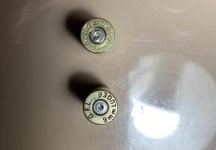Hello,
I’m new to reloading and I need some advice.
I use Berrys Bullets, 9mm, 115 grain, round nose double strike, .356 with Accurate #2 powder. The Accurate #2 load data indicated a range of 4.2 - 4.7.
Both casings in photo were loaded with 4.2 grains.
I have been informed the casing with the ripple or crater appearance indicates an overpressure and I should reduce the load.
I have used both 4.2 and 4.3 grains in both my Glock 26 and Beretta 92FS.
Never had any jamming and accuracy seemed very good.
Two questions: Am I “overloading” causing an overpressure?
Should I use Lead Cast Round nose Data which indicates 3.9-4.4 grains?
Thank you very much in advance for considering my lengthy question.
I’m new to reloading and I need some advice.
I use Berrys Bullets, 9mm, 115 grain, round nose double strike, .356 with Accurate #2 powder. The Accurate #2 load data indicated a range of 4.2 - 4.7.
Both casings in photo were loaded with 4.2 grains.
I have been informed the casing with the ripple or crater appearance indicates an overpressure and I should reduce the load.
I have used both 4.2 and 4.3 grains in both my Glock 26 and Beretta 92FS.
Never had any jamming and accuracy seemed very good.
Two questions: Am I “overloading” causing an overpressure?
Should I use Lead Cast Round nose Data which indicates 3.9-4.4 grains?
Thank you very much in advance for considering my lengthy question.

